- Author Arianna Cook [email protected].
- Public 2024-01-12 17:55.
- Last modified 2025-06-01 07:38.
Description, tips for caring for arum when growing in the open field, reproduction, solving problems that arise during care, notes for florists, types and photos of the plant. Arum is often called Arum and belongs to the Araceae family. This association of flora representatives contains perennials with a herbaceous form of growth. Scientists have counted more than 3000 species in it, but according to the Plant List database, there are almost 30 species in the genus. Growing areas, which fall on the northern lands of the African continent. This includes the forests of the southern regions of Europe and the Caucasus, as well as Central Asia. But in our latitudes, it is customary to grow this plant as an annual, planting it in gardens or as a pot culture.
| Family name | Aroid |
| Life cycle | Perennial |
| Growth features | Herbaceous |
| Reproduction | Seed and vegetative (lateral processes or division of the rhizome) |
| Landing period in open ground | Mid or late May |
| Disembarkation scheme | The depth of the hole is not more than 8 cm, the distance between plants is 40 cm |
| Substrate | Nutritious, drained |
| Illumination | Partial shade or a place in the shade |
| Moisture indicators | Moisture stagnation is harmful, watering is moderate, drainage can be used |
| Special Requirements | Unpretentious |
| Plant height | 0.15-0.9 m |
| Color of flowers | Red, hot pink, yellowish or creamy pink |
| Type of flowers, inflorescences | Ear |
| Flowering time | May |
| Decorative time | Spring-summer |
| Place of application | Curbs, garden bed, rock garden, stone gardens |
| USDA zone | 4, 5, 6 |
Aronnik bears its name in Latin thanks to the word in Greek “aron”, which the famous naturalist and versatile scientist of antiquity Theophastus (about 370 BC - 288-285 BC) named in his writings one of the species of this genus … Often the plant is called according to transliteration Arum or "Arum beard", "serpent-grass" and similar unflattering epithets, since the fruits of the plant are very poisonous.
Arum is the owner of horizontally growing tuberous rhizomes, hemispherical or ovoid. These perennial grasses are small in size, rarely exceeding 60 cm in height. They have a dormant period. Moreover, their foliage begins to develop only when the flowering process is completed. A large number of leaf plates are formed, they are usually arranged in a spiral order on the stem. The leaves have sheaths, and there are 2-3 petioled leaves. Leaf sheaths can vary in length from short to elongated. The petiole at the base is characterized by an expansion resembling a vagina. The shape of the leaves can range from cordate to arrow-shaped or sagittal-spear-shaped. On the surface of the leaf, the primary veins are pinnate and they can form at least one single common one; from the veins of a higher order, a pattern resembling a mesh is formed.
The flowering period falls on the days of May, when the soil is already well warmed up under the rays of the sun, but an openwork shade will be provided under the crowns of trees. An inflorescence is formed on the bare and powerful flowering stem, which to many resembles an ear of Arisaema, the "sister" of the family. The ear is made up of small buds, which, when blooming, can have petals of red, bright pink, yellowish or creamy pink colors. Flowers are unisexual, without perianth.
After a short period of time, a leaf-covering of the bracts grows around the cob. Such a leaf has a high density and in length its parameters can approach 0.5 m, reaching 10 cm in width. This bedspread has an olive or light green tint, but there are varieties that have a pattern of stripes and specks on its surface other tones. But inside such a leaf has a beautiful bright crimson color. Because of its foliage and inflorescences, arum is very similar to calla lilies.
In the middle of summer, after the flowering ends, and pollinators arrive, which are flies (meat, dung or carrion flies), and mosquitoes are for the Aronnik canofolloid variety, the berries ripen. These fruits are very fleshy, red or orange in color. Inside the fruit are several seeds with a shape that varies from ellipsoid to ovoid. At the same time, it is curious that with the arrival of August, all the foliage will die off and the plant will only have a peduncle, on which only fruits will be adorned, becoming bright scarlet and glossy.
Arum Grow Tips, Outdoor Planting
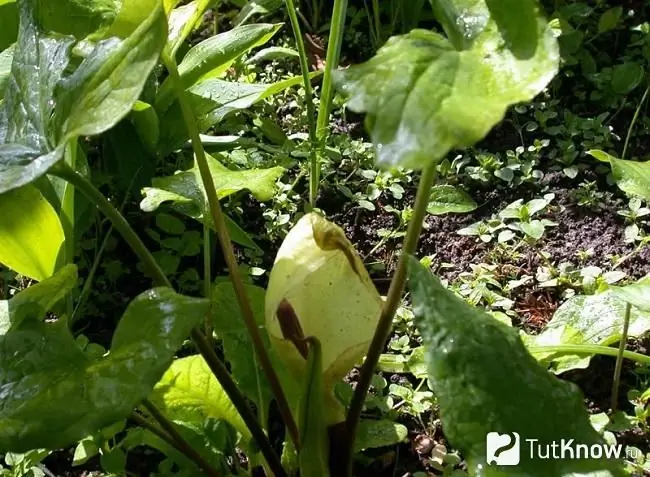
- Drop off location. Since the plant grows in nature under the canopy of tree crowns, when planting in open ground, a flowerbed protected by shading is selected so that the foliage of the trees provides an openwork shade. You can also plant such bushes in the shade of buildings, but there is information that the "snake-grass" will be good in the sun.
- Planting soil arum plays an important role. It is recommended to use a calcareous nutrient substrate with good drainage and moisture penetration properties. It is necessary to lay a drainage layer on the bottom of the pit to protect against waterlogging, which can be expanded clay or broken brick of small size.
- Planting arum. The depth of the hole for the "arum beard" should not be more than eight centimeters. It is best when the plants will not interfere with each other, growing, so they can stand up to 40 cm between them. It is important to place arum cuttings in open ground when it warms up well in the sun, and this is possible in the middle or late May days.
- Fertilizers for arum entered from the beginning of March. It is recommended to use complex mineral preparations twice a month. You can use organics.
- Watering. The plant suffers most of all when grown in the open field from waterlogging, since the tubers quickly rot. Therefore, moderate watering is necessary, especially in the summer heat. But if the bushes are planted in a shady place, but such soil moisture is not required.
- Arum wintering outdoors. It is best to organize a shelter for planting for the winter period, using fallen leaves or spruce branches, since some species, although they are winter-hardy, can significantly freeze and die during severe winters. You can use agrofiber for shelter.
- Application in landscape design. Aronnik has long been known to phytodesigners for its decorative features. With its help, European flower beds or flower beds are often decorated. It is because of its property to bloom beautifully in the shade, the plant is planted in places where no other representatives of the garden flora can grow normally and even just survive. Often, with the help of "grass snakes" they decorate balconies and terraces.
Arum breeding
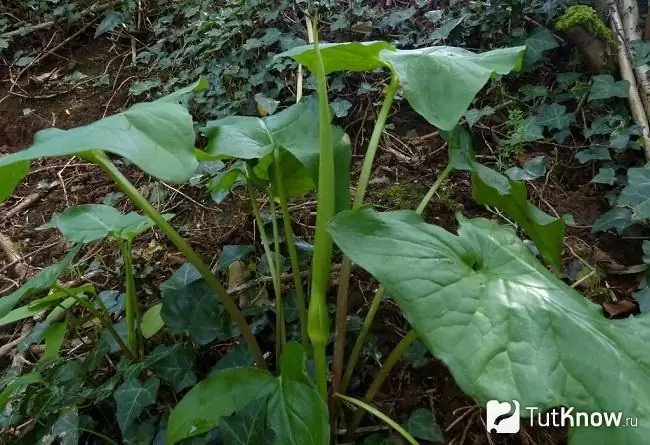
To obtain new plants of the "arum beard", it is necessary to use seed and vegetative (lateral processes or division of the rhizome) methods.
It is possible to divide the tuberous rhizomes of all types of arum, except for the elongated one, since this variety has a very slow growth rate of the underground part. The division is performed in August, when all the foliage dries up. Planting arum cuttings in open ground should be 8 cm deep, while maintaining a distance of 40 cm between them.
During the growing season, lateral shoots can form at the bush, which can also be planted with the arrival of September. To do this, you need to carefully dig in the mother bush, and then use a sharp garden tool to cut the tubers, leaving a sufficient number of stems on the divide. The rules for planting parts of the "serpent-grass" remain the same.
If seed is used, then it is sown before winter so that natural stratification takes place. Reproduction by self-seeding is possible.
Solving problems arising when caring for an arum
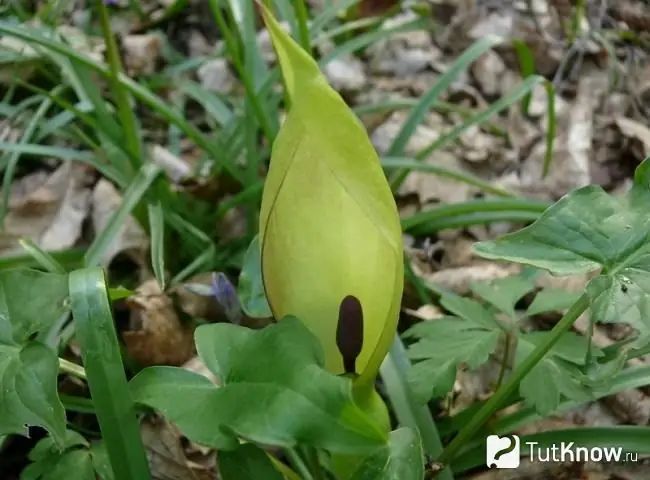
When growing an "arum beard" in the open field, you should not be afraid of pests, they are not interested in the plant, but occasionally it is affected by ticks or nematodes. Spraying with insecticides is recommended.
If the substrate is constantly in a waterlogged state, then fungal diseases may develop. These processes lead to decay of the tuberous rhizome, which is manifested by the formation of brown spot on the foliage. In case of severe damage, you need to dig up the plant and burn it. When there is an opportunity to save the bush, the affected parts are removed and the fungicide treatment is performed.
The following problems are possible with garden cultivation of arum:
- the foliage at the ends turns yellow, which indicates watering with too chlorinated water, therefore, they use settled water;
- the lethargy of the stem indicates the flooding of the soil, possibly its rotting;
- if the leaf begins to dry out along the edge, then this is evidence of a lack of fertilizers;
- with brittle leaves, spraying with cool water should be carried out after the sun has set.
Notes for flower growers about arum and flower photo
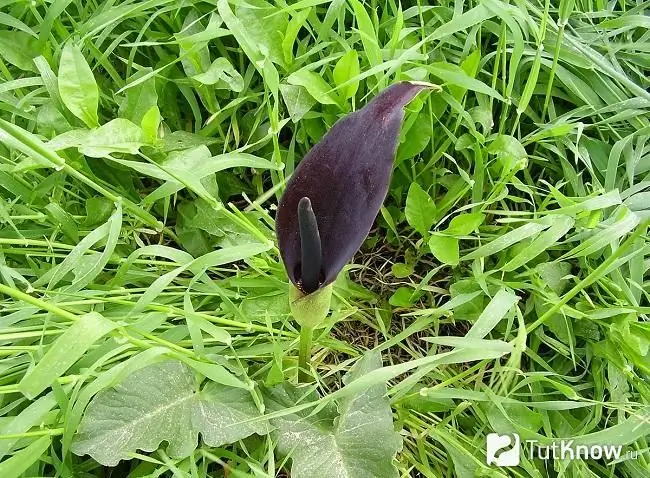
Despite the fact that the arum contains many toxic substances, it is the favorite food of wild boars and therefore is popularly called the "pork lily". The thickets of Arum for caterpillars of the dark brown ribbon moth (Noctua janthina) and hawk moth (Theretra silhetensis) are plants for their food.
Important
Since a large amount of alkaloids is present in the parts of the arum, when growing in the garden, you should choose a place that is not accessible to children. If a person eats such berries, then it threatens with serious poisoning. But since the fruits of arum do not have a pleasant taste, it will be difficult for a child to swallow a lot of them. However, after the berries are dry, their toxic properties are lost. There are species that, due to the possibility of extinction, are listed in the Red Data Books of some countries (Ukraine, Russia and Kazakhstan): Aronnik white-winged, Aronnik elongated and Aronnik Korolkova.
On the territory of Dalmatia, it is customary to dry the rhizome, grind it into flour and then mix it with wheat. If the tubers "snake-grass" are fried, then they can be used for food. The foliage of this plant is used to bleach linen in England and Belgium.
Homeopaths in their arsenal also use arum for the manufacture of drugs that have expectorant, anti-inflammatory and antirheumatic effects. But it is necessary to use such drugs only under the supervision of a doctor. If there is a tear in the vocal cords, then you can use drops of this plant. This mainly concerns the variety of Arum spotted.
Arum types
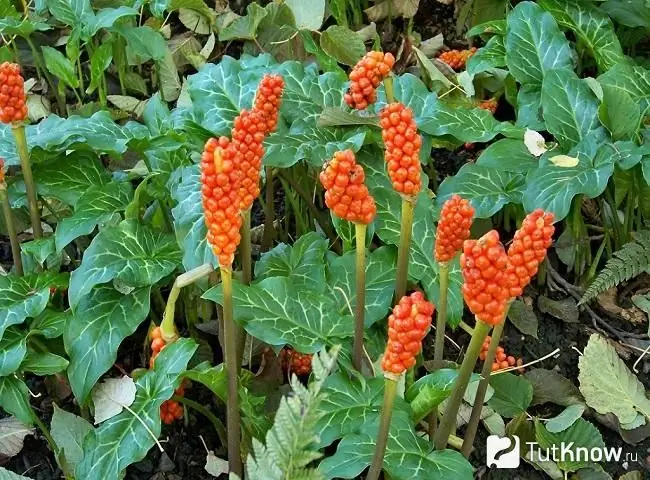
- Spotted Arum (Arum maculatum). It is a herbaceous plant with a long life cycle, the height of the stems can reach 10-25 cm, but occasionally it approaches 65 cm. The color of the foliage is light green, with an unusual pattern of specks of yellow or purple tones. The shape of the leaf plate is arrow-shaped; the leaves are crowned with elongated petioles. The cob-shaped inflorescence is wrapped in a variegated sheet-blanket and is located on a peduncle, which is equal in height to the leaves. Flowers collected in an inflorescence of brown-purple color. The flowering process begins in mid-May and lasts up to 30 days. Ripening berries are first tinted green, which later changes to scarlet. The species is frost-resistant, can reproduce by self-seeding. In nature, it is often found in the Balkans, and can grow on the lands of Moldova and Ukraine. Tuberous rhizome is used for the manufacture of homeopathic medicines.
- Aronik italicum (Arum italicum) can be found under the name Aronnik italikum or Aronnik white-winged. This variety is the most thermophilic and may not even bloom in temperate climates. However, its seeds are very popular among flower sellers. Perennial, herbaceous form, the maximum height of which is 70 cm. The rhizome is underground, tuberous. Leaf plates in length measure from 35 cm to 69 cm. The outlines of the leaf are in the form of a spear, the surface is matte, the edge is wavy. Above there is a pattern of stripes of golden or whitish color, reminiscent of Italian marble. The flowering process begins in mid-spring and lasts until early summer. The flowers are unisexual and rather small, gather in a cob-shaped inflorescence. The color of the petals in the flowers is pastel, creamy yellow. The inflorescence is covered with a veil up to 30 cm long. Its color is yellowish-green, occasionally taking on a crimson hue from the outside. After pollination of flowers in August, berries of a green color ripen, which changes to red as they ripen. Fruits are collected on the cob-inflorescence axis. The species has its specific name from the area of its natural distribution, which falls on the southwestern regions of Italy. There, this plant can be seen near forests and vineyards or on hills with a height of about 800 m.
- Aronik Cretan (Arum creticum). This variety is perhaps the most decorative of the genus. The foliage is painted in a dark green color, the shape of the leaf plate resembles an arrow. The resulting inflorescences have a fragrant aroma. The ear is made up of flowers of golden color and wrapped in a yellow or orange sheet-blanket. This leaf cover can extend up to half the length of the plant itself, which is 30-50 cm tall. In this case, the diameter of the bush is measured 20 cm. This variety is thermophilic and for the winter period the plant will need to be covered, otherwise it may freeze out.
- Elongated Aronica (Arum elongatum). This variety is the most frost-resistant and unpretentious. The native habitat extends to the lands of the Crimea and the Ciscaucasia. A perennial of small size, which does not exceed 35 cm in height. The foliage is spear-shaped, its lateral lobes have a bend back. The stem is elongated, fleshy and powerful. The peduncle is oblong in shape, its apex is crowned with an cob-shaped inflorescence. It is made up of purple flowers. The ear is wrapped in a blanket of a whitish or greenish tone on the outside, while its inner side is dark purple, velvety to the touch. This leaf is no more than 25 cm long, at its top it is decorated with an elongated pointed point, which gave the aron its specific name. The flowers have an unpleasant odor that attracts dung flies for pollination. The flowering process falls on the period from April to May. The rhizome of this species grows at a very low rate, therefore it is recommended to use the seed method of reproduction. Cultivation in central Russia is possible, but for the winter it will need shelter with fallen leaves or spruce branches.
- Common Arum (Arum dracunculus) also referred to as Tarragon. This plant is large in size and can reach 90 cm in height. The color of the leaves is pale greenish. The length of the leaf is measured by 20 cm, there is a division into segments. Powerfully shaped stems and foliage stalks feature a pattern of brown specks, which makes them resemble the skin of an exotic snake. The sheet-cover with which the cob-shaped inflorescence is wrapped can be almost half a meter. Its outer side is painted bright green, the inner part is burgundy. The inflorescence is made up of purple flowers. The flowering process begins with the arrival of summer.






